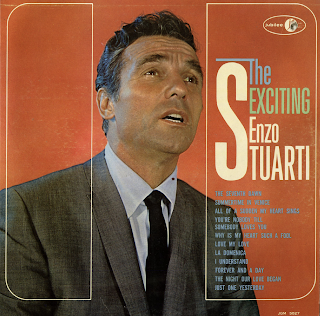Pavanne
This Is Glenn Miller
RCA Victor LPM 1190
1956
From the back cover: One of the country's leading dance band critics once said, "Of all the leaders I've ever met, the one who knows most what he wants, and who's best able to get what he wants from his men, is Glenn Miller!"
There were several reasons for this. Glenn Miller was a forceful man. He was also a thoughtful and intelligent man, He planned his moves carefully, but once his mind was made up, nothing could deter him from making those moves which he had planned.
He was gifted with both a commercial sense and musical education and taste. He was a business man, who appreciated the difficulties that musical purists face when dealing with the general public, but who perhaps appreciated even more the facts that a leader of a dance band must face up to his obligations to his dancers and listeners, his musicians and their families, and to his investors and himself.
Glenn took all these viewpoints under wise and careful consideration whenever he made his moves. This meant selecting not only proper material, songs and arrangements for his orchestra, but also working personnel who would help him steadfastly to carry out his plans.
His musicians were well disciplined by Glenn himself, who, because of his extensive musical education and experience, was able to tell them clearly and concisely what he wanted them to do, and also to make sure that they did as directed. The results were reflected in his clean, clear sectional and ensemble sounds. Being a jazzman at heart, however, he never interfered with his musicians' ad lib solos, permitting sidemen like Tex Beneke and Billy May and Johnny Best and all the rest complete freedom whenever the arrangements called for hem to go out on their own.
Those arrangements, too, stemmed from Glenn. It was he who created the band's distinguishing trademark the use of the clarinet with the saxes, the ooh-war's of the brass, the ingenious use of various types of mutes. He wrote some of the arrangements himself. Others he discussed in advance with Jerry Gray, who then carried out the final musical plans. There was just one exception. Glenn had discovered a brilliant young arranger named Bill Finegan (now one half of the Sauter-Finegan band duo), who was permitted almost complete free rein with his writing.
The opening selection of this album, Johnsons Rag, is a Finegan arrangement, presenting one of those slow build-ups, culminating in a rousing finish, that characterized so many of the band's swing numbers. The first eight bars of tenor are by Beneke, the second two by Al Klink. Glenn takes the trombone break and Clyde Hurley the trumpet solo.
My Isle Of Golden Dreams is another arrangement by Finegan, sporting some pretty Beneke tenor and a tempe change that musicians have often admired but which has startled many a confused dancer.
Anvil Chorus, arranged by Jerry Gray, shows off the band's magnificent ensemble execution, plus solos from Beneke, trumpeter Billy May, clarinetist Ernie Caceres and bassist Trigger Alpert.
At Last is one of the most successful of all Glenn Miller's ballad renditions. This version show the wonderfully rich sounds that the orchestra was able to produce.
Sun Valley Jump, from the movie "Sun Valley Serenade," is a typical jumping blues, written by Jerry Gray, and showing off much of the musicians swinging talents.
Chattanooga Choo Choo is one of the band's all-time successes, a happy swinging novelty, complete with lost of singing and whistling from Tex Beneke – a versatile lad, he – and that a fine Miller vocal group, the Modernaires. This is the version from the "Sun Vally Serenade" sound track.
Side Two of this album begins with a lovely arrangement by Jerry Gray of the well-known waltz, Beautiful Ohio, complete with Beneke's tenor and one of Chummy MacGregor's few recorded piano solos. (MacGregor was probably Glenn's closest friends, the band's oldest member in point of service, and extremely popular with everyone connected with the outfit).
Pavanne, the familiar Morton Gould composition, gets the Miller band treatment via another Finegan arrangement, with Beneke and Miller's trombone, again spotted.
Danny Boy, one of the band's oldest arrangements, written by Miller and MacGregor, features Chummy on celeste and some very pretty Miller horn. This number used to be especially effective on theater dates.
Adios is another tasty, sweet arrangement by Jerry Gary, with Mickey McMickle supplying the pretty muted trumpet passage and Doc Goldberg plucking the clean bass notes.
Serenade In Blue, another standard ballad with the band, is herewith presented in a concertized arrangement, complete with some very lovely John Best trumpet played against the saxes, good Ray Elberle singing and more pretty Beneke tenor saxing.
Bugle Call Rag, like the preceding selection taken from the sound track of the band's movie, "Orchestra Wives," is a typical Miller screaming flag-waver, fast, loud and jumping, generating a maximum amount of musical excitement for the Miller fans.
This, then is Glenn Miller – the man and his music – one of the really great leaders of one of the really great dance bands of this or any other age. Listen and you will know why. – Notes by George T. Simon - George T. Simon, former editor of Metronome, is now free-lance recording producer and television writer.
Johnson Rag
My Isle Of Golden Dreams
Anvil Chorus
At Last
Sun Valley Jump
Chattanooga Choo Choo
Beautiful Ohio
Pavanne
Danny Boy (Londonderry Air)
Adios
Serenade In Blue
Bugle Call Rag




























